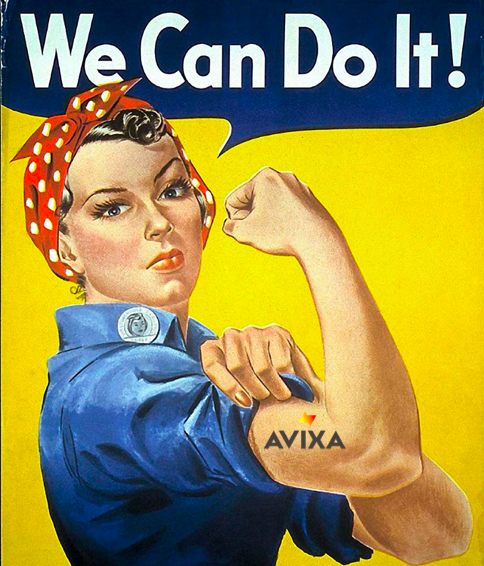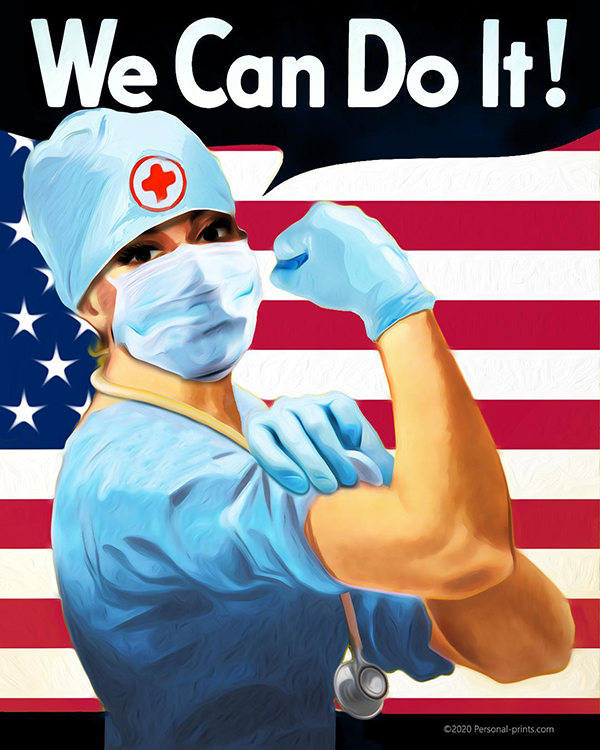Remembering Rosie, and Why Now More Than Ever, We’re Like Her

This March, the AVIXA Women’s Council joined in the celebration of International Women’s Day and Women’s History Month, which was also the centennial anniversary of women winning the right to vote. Sadly, March has also marked the passing of a women’s rights icon; Rosalind P Walter, known to us as Rosie the Riveter.
Born into an affluent family in Long Island, NY, Rosalind gave up her opportunity to attend college in order to support the World War II effort by working night shifts driving rivets into the metal bodies of corsair fighter planes. Rosie’s commitment to helping America during the turbulent times of war inspired song writers Redd Evans and John Jacob Loeb to write the inspirational lyrics about Rosie: “She’s making history, working for victory” This 1942 song is what transformed Rosie into the famous women’s rights icon of “Rosie the Riveter” we know today.
During WWII, 350,000 women in the United States joined the war effort. During the height of the popularity of the “Rosie the Riveter” campaign, 1940-1945, the percentage of women in the U.S. workforce jumped from 27 to 37 percent. Jobs that were not ever an option for women pre-war, were now open opportunities for them while men were away fighting in the war. For example, women held less than 1% of aviation jobs before the war, but f 65% of those jobs during the war. Even though women had stepped up to fulfill vacancies in job positions originally held only by men, female workers made less than 50% of what their male counterparts earned both before and after the war. WWII represented a powerful time in the women’s rights movement, as the confidence women gained from working previously considered “men’s only” jobs led them to fight for equal rights.
The AVIXA Women’s Council (AWC) has found representation extremely important for empowering women and making them feel a sense of belonging. The reason the “Rosie the Riveter” campaigns were so successful in inspiring women to join the workforce in World War II was its ability to reflect a woman working a “man’s job.” Because of the impact that the call for women in the workforce during World War II had on society, Rosie’s image elevated from that of just war propaganda, to a women’s rights icon that we as a council still proudly display.

America’s demand for working women during WWII not only changed the path of women’s rights forever, it also impacted government supported childcare. First lady Eleanor Roosevelt traveled the country interviewing working women to determine what support they would need from their government. Eleanor’s research found that of the three million women that had joined the workforce during the “Rosie the Riveter” era, 33 percent of these women had children under the age of 14 and were in desperate need of childcare support. These women that both needed to work to financially support their families in their husband’s absence and yearned to support their countries war effort, struggled to simultaneously care for their children and home while working full-time. In 1942, in support of working mothers, Eleanor pushed her husband President Roosevelt to approve the first ever government-sponsored childcare center under the Community Facilities Act. By 1945, more than 1.5 million children were assisted under the new child care act.
Although as a country we are currently lucky enough to not be fighting a world war, we are still banding together as a country to fight a virus that threatens our society. With the closure of schools and many childcare facilities, women are expected to take care of their children and provide support for home schooling while still working full time jobs remotely. Although we have come a long way since women were called to join the work force in the 1940s, we still only make an average of 77 cents on the dollar to our male counterparts.
AVIXA Women’s Council members are not immune to the struggles of working remotely at home while needing to take care of their children or guide them through homeschooling. The council is taking advantage of the strong network of women to support each other, and especially the mothers in the group, who are all fighting a similar battle. Brandy Alvarado, Chair of the AVIXA Women’s Council, shares her experience of working from home, running the council through virtual platforms, and having her daughters at home full time:
“I have two daughters with a huge age gap. At this point, I have never been more thankful for that gap. My oldest daughter is finishing up college to become a teacher, and my youngest is a first grader. Having a budding teacher to help with the home schooling has been such a blessing. I’ve been working from home for a few weeks now, and I think we’ve finally gotten into a groove. I feel like I’ve finally come out of hiding. I’d been very quiet on social media as I was trying to get my home schooling and work from home routine established. If I’m being honest, I feel drained and very disconnected. Caring for the kids, my significant other, my family, and working is a lot to take on, and then trying to keep all of us safe on top of that has really begun to take its toll. Someone asked me what I was doing in “my spare time”? I laughed myself silly. What the heck is spare time?”
Brittany DiCesare, Manager of Professional Society Member Programs at AVIXA, also shares her new narrative on finding a practical routine during an international pandemic:
“Working from home with a 5-year-old and 14-month-old isn’t for the weak. Like other parents in the world today, not only am I responsible for my full-time workload I am also responsible for teaching my children – a role I take seriously – while also maintaining the home, making sure my children get some play time, fixing lunches, kissing boo-boos and the list goes on and on. Now, I’m one of the lucky ones who doesn’t have to do this on her own every day. Although my husband is an essential worker, he’s only required to be out of the home two days a week. So, what does that mean for our new normal? It’s become all about teamwork and balance. On Sundays, we sit down, discuss what our week looks like, and make a plan for our children. Every night we set out schoolwork so that both my husband and I can provide direction, depending on which one isn’t in a meeting at the time. It also means that we often spend our evenings working after our children are in bed.”
Just as the women’s rights movement was propelled by the thousands of mothers working during the war effort, the working mothers of the AWC are using the council platform to share their stories which helps them in knowing they are not alone and empowers them to stay strong to get through this. Kate Calderon of the Orlando AWC local group is currently working remotely with both a 3 and 4-year-old at home.
She shared her story in that “being a working mother has always had its challenges, but this goes beyond anything we've ever experienced. Trying to find a balance between getting work done, running a household, and caring for small children among everything else and during a mandatory quarantine where we're also not able to leave our homes for a much-needed mental clarity break?! It can be insanity. However, she says a big takeaway for her was: “What I've learned from this pandemic is giving yourself grace. This is new for everyone. It's certainly brought our mom-tribe closer together! Having a group of women that you can vent, scream, cry, love on, and support is truly invaluable at a time like this.
Kate has been finding comfort in a quote by Eleanor Roosevelt that is extremely applicable to our current situation. "A woman is like a tea bag; you never know how strong it is until it's in hot water." As we find ourselves in our own metaphorical hot water, it’s comforting to know that the AVIXA Women’s Council has responded by accomplishing exactly what was intended when the council was originally formed; supporting and empowering the women of our industry. The silver lining for women who endured WWII was the reward for being recognized as capable of fulfilling jobs that had previously been designated for men only and saw the dawn of a new era for women in the workforce. As working mothers during the war, the government’s response to childcare proved the strain put on mothers to work full time and raise families could not be ignored. Perhaps, a positive outcome of our current position will be a new gained respect for the working mothers of our industry and a rise in equality for all women in the workforce.
To get involved in the AVIXA Women’s council or for more information on virtual local group meetings, please visit: avixa.org/avixawomen






